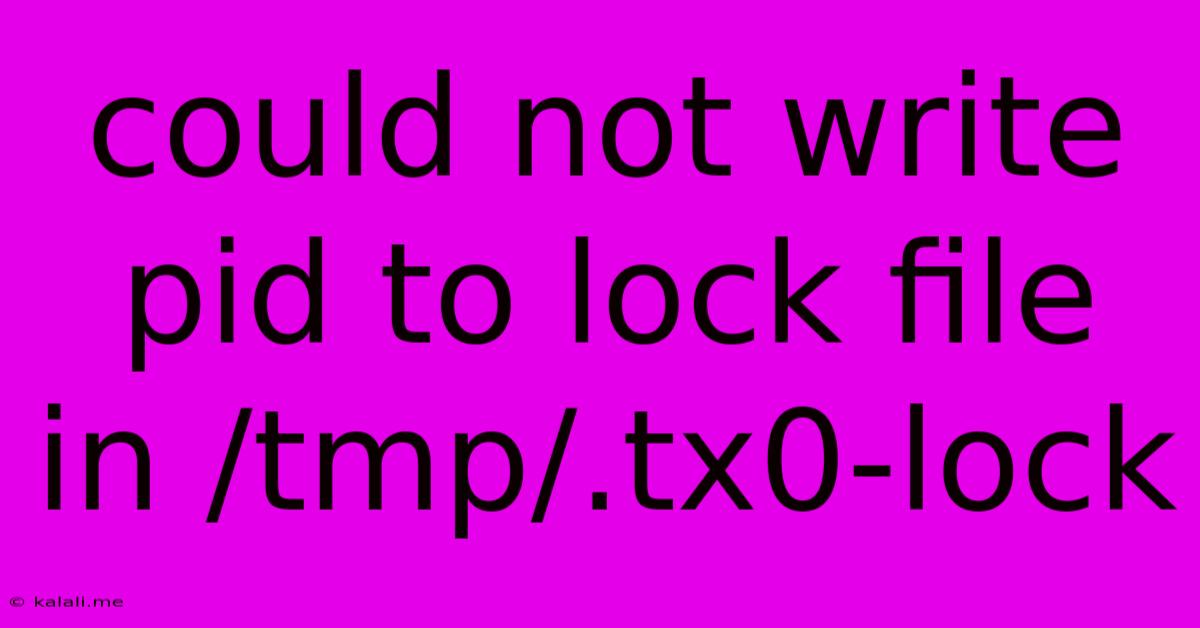Could Not Write Pid To Lock File In /tmp/.tx0-lock
Kalali
Jun 05, 2025 · 3 min read

Table of Contents
Could Not Write PID to Lock File in /tmp/.tx0-lock: Troubleshooting and Solutions
The error message "Could not write PID to lock file in /tmp/.tx0-lock" is a frustrating one, often encountered when working with applications that utilize file locking mechanisms for process synchronization. This usually indicates a problem with file permissions, access to the /tmp directory, or a conflicting process already holding the lock. This article will explore the common causes and provide practical solutions to resolve this issue.
Understanding the Error:
The error arises when a program attempts to create a lock file (in this case, .tx0-lock within the temporary directory /tmp) to prevent multiple instances of the same program from running concurrently. The PID (Process ID) is written to this file to identify the process holding the lock. Failure to write the PID signifies a problem preventing the program from acquiring exclusive access to this file.
Common Causes and Solutions:
1. Permissions Issues:
- Problem: The user running the application might lack write permissions in the
/tmpdirectory. - Solution: The simplest solution is to verify and adjust the permissions of the
/tmpdirectory. You can usually achieve this using thechmodcommand in a terminal or command prompt. For example, to grant write access to all users, you could try:sudo chmod 777 /tmp(Caution: While this works, it's generally considered a security risk to grant wide open permissions to/tmp. It's better to address the underlying cause of the permission issue.) A more secure approach involves using your user's group with appropriate permissions.
2. Conflicting Processes:
- Problem: Another instance of the same application or a different process might already be holding the lock file.
- Solution: First, identify the process currently holding the lock (if any). This may require using system monitoring tools like
ps aux | grep .tx0-lock(or a similar command depending on your operating system). If a process is found, terminate it gracefully usingkill <PID>(replacing<PID>with the process ID). If a graceful termination fails, you might need to usekill -9 <PID>(force kill - use with caution). After terminating the process, try running the application again.
3. /tmp Directory Issues:
- Problem: The
/tmpdirectory might be full, corrupted, or inaccessible due to other system issues. - Solution:
- Check Disk Space: Use
df -hto check available disk space. If/tmpis nearly full, delete unnecessary files to free up space. - Check for Corruption: While less common, corruption can interfere with file access. A system check might be necessary (e.g.,
fsckfor ext file systems - but use with caution and only if you know what you're doing, as this can lead to data loss). - Inaccessible
/tmp: If/tmpis mounted improperly or has other accessibility problems, the underlying system issue must be resolved. Consult your system administrator or relevant documentation.
- Check Disk Space: Use
4. Application-Specific Issues:
- Problem: The application itself might have a bug in its locking mechanism.
- Solution: This is the most complex scenario. Check for updates to the application or consult the application's documentation or support channels for assistance.
5. Antivirus or Security Software Interference:
- Problem: Security software might be interfering with the application's attempt to create the lock file.
- Solution: Temporarily disable your antivirus or security software to see if it resolves the issue. If it does, add an exception for the application within your security software's settings.
Prevention:
- Proper Permissions: Ensure your user has the necessary write permissions in the
/tmpdirectory, but avoid overly permissive settings (like777). - Robust Locking Mechanisms: Applications should use robust locking mechanisms that handle potential errors gracefully.
- Regular System Maintenance: Regularly check disk space and perform system maintenance to prevent issues that could cause this error.
By systematically checking these points, you should be able to identify and fix the "Could not write PID to lock file in /tmp/.tx0-lock" error and get your application running smoothly. Remember to always back up important data before making significant system changes.
Latest Posts
Latest Posts
-
Til There Are No Skill Checks Just Ability Checks
Jun 07, 2025
-
Why Couldnt Moses Enter The Promised Land
Jun 07, 2025
-
Why Does Nasdaq Not Publish Order Book Anymore
Jun 07, 2025
-
What Is A Naturalized Or Derived Citizen
Jun 07, 2025
-
Where Can I Watch Boku No Pico
Jun 07, 2025
Related Post
Thank you for visiting our website which covers about Could Not Write Pid To Lock File In /tmp/.tx0-lock . We hope the information provided has been useful to you. Feel free to contact us if you have any questions or need further assistance. See you next time and don't miss to bookmark.